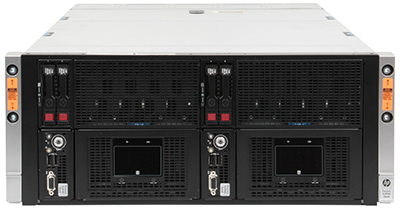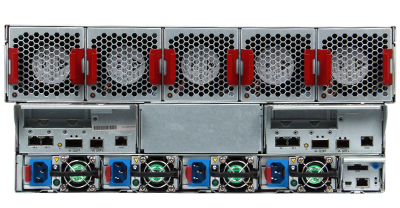Email: [email protected] Ligue agora! +55-11-3717-5537

The highly efficient converged design offers a balance of performance and storage capacity in a densely-packed 4.3U space. The converged infrastructure design means cooling, power, and network communications are handled at the chassis level to conserve energy usage. This server is ideal for parallel processing applications like Hadoop.
Administrators can choose from three different chassis configurations: a 1×60 chassis with one compute node and 60 hard drives, a 2×25 version with two compute nodes each accessing 25 hard drives for 50 hard drives total, and a 3×15 chassis version that supports three compute nodes that each control 15 hard drives for a total compliment of 45 hard drives.

All processors are supported on the compute nodes, which feature Intel’s C600 series chipset and support a maximum of two E5-2400 or E5-2400 v2 processors. The system will support up to four power supplies either 750W or 1200W hot-pluggable with up to a 94% efficiency rating.
A maximum of 384GB of memory is supported on the compute node with a two processor configuration. Each processor supports six memory slots for 12 memory slots total. Only Registered (RDIMM) memory modules are supported on the system, and depending on your choice of processor, may run at 1600MHz, 1333MHz, or 1066MHz. HP SmartMemory is recommended in order to realize the full memory performance of 1600MHz and enhanced functionality.
Each compute node supports two SFF drive bays and are located on the front of the system. With two separate drives on the compute module, the boot/OS can be located on a separate controller. The Personality board connects the compute node power and network communications to the SL4540 chassis.

Chassis mounted hard drives are only accessible with the top cover panel removed. The Chassis itself comes in three different configurations as mentioned above: A 1×60 with one node and 60 hard drives, a 2×25 with two nodes and 50 hard drives split between the compute modules, and a 3×15 with three compute nodes and 45 hard drives divided between the compute nodes. All drives supported on the main chassis of the SL4540 are hot-plug, SAS/SATA HDD or SSD, large form factor (LFF) drives. The main storage section of the SL4540 can be outfitted with any combination of drive types depending on your target performance.
Storage controllers are housed in both the nodes and in the chassis I/O modules. An HP Dynamic Smart Array B120i SATA RAID controls only the two SFF drives supported on the compute node. Each I/O module will support one H220 HBA, or two P420i Gen8 storage controllers to manage the hard drives located in the chassis. However, if two P420i controllers are needed you will not need the HP SL4550 Storage Mezzanine. The Storage Mezzanine is required to enable low-profile PCIe slots in the I/O module to support other expansion options like the I/O accelerator and other external storage options, like the H220 HBA.

A single PCIe 2.0 slot is dedicated to each server node and is activated by the HP Server Storage Mezzanine to PCIe option kit. The Storage Mezzanine is also required when incorporating other expansion card options like the HP I/O accelerator, additional networking options, or the external controllers as mentioned above. An integrated Matrox G200 video chip is standard on the compute nodes.
As a basic rule of thumb, one I/O module is required per compute node, so for the 2×25 chassis you need two I/O modules and the 3×15 you need three I/O modules. This system supports High Performance Computing with high-speed InfiniBand and 10Gb interconnects. The chassis I/O modules come standard with an HP Smart Array P420i Controller. The Chassis I/O modules also support the network controller with either an HP Ethernet 1Gb 2-port 361i, or the 361i with a 10Gb 2-port 544i adapter.
HP Insight Management offers a suite of tools to simplify management and provisioning of the SL4540. If this system is being added to a network with a pre-existing SL4540 chassis, then the software will “discover” the newly installed system negating the need to install the management software. iLO is a standard feature on all ProLiant servers and helps with setting up the system, health status, power optimization, and remote server administration. iLO can access the system agent-free regardless of whether the system is on or off. HP’s Active Health collects data, monitors changes to system configuration, and records changes.
For security, Trusted Platform Module (TPM) can be installed on the server node and can be used in conjunction with drive encryption technology software.
Core Options:
2 sockets per blade
DIMM Slots Available:
Maximum (RDIMM) (per server tray):
NOTE: Depending on the memory configuration and processor model, the memory speed may run at 1600, 1333MHz or 1066MHz.
Optical Drive:
Drive Bays:
NOTE: Each node contains two SFF (2.5”) hard drive bays on the front of the node.
SFP+ connector
QSFP connector
USB
Serial
Video
Management Network Port
Health LED
Power
UID for node
UID for storage
HP Insight Management